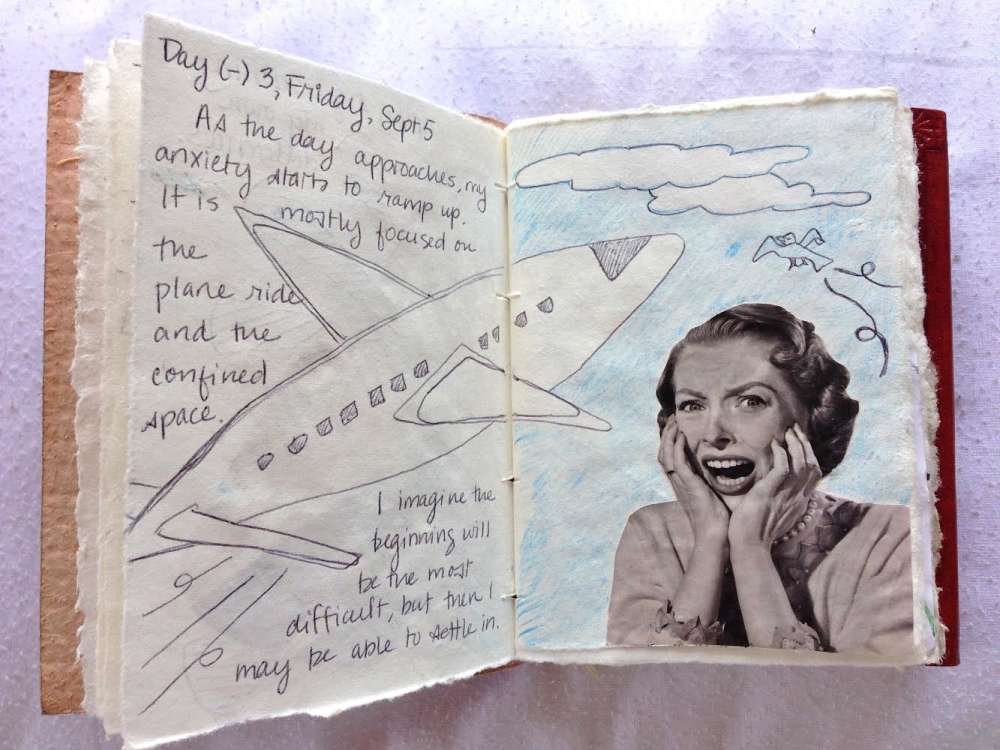Cognitive Behavioral Therapy (CBT) uses a combination of cognitive therapy, changing what you think, and behavior therapy, changing what you do. CBT is the favored treatment for anxiety, but it has been criticized for being too abstract or verbal. This is where art comes in—giving a concrete form to the intangible. In two recent case studies, I found art could be combined with CBT to help treat anxiety disorders. Those with severe anxiety will want to work with an art therapist, but there are simple ways you can use art and CBT for smaller, everyday anxiety.
1. Psychoeducation
According to CBT, people need all the facts about their anxiety before they can work towards decreasing it. CBT treats anxiety like a machine. Once you know all the parts and how the machine works, you can disassemble and reassemble it. Often, CBT requires you to keep track of your anxiety by documenting what triggers it, how you react, and how you try and cope with it.
Recording the experience of your anxiety can be hard using words alone, but images may help you capture and symbolize complex emotions. Keep a visual journal to learn about the way you experience anxiety—physical feelings, thoughts, and behaviors. Make a note of the situations that lead to your anxiety or stress
- Where were you?
- What happened?
- What did you do?
Collage a visual anxiety cycle from cutout magazine images, gluing them in the order they occur.
2. Breathing and Relaxation
To decrease anxiety, CBT recommends slow abdominal breathing and progressive muscle relaxation (contracting and releasing muscle groups). Therapists often follow these exercises with guided imagery, so that relaxing images will be associated with physical relaxation.
Enhance this exercise by creating a response painting or clay sculpture after a relaxing activity such as yoga, meditation, or listening to music. Choose your favorite. Photograph your artwork and print a version for your wallet or car to remind you of the relaxing activity. Coloring mandalas and other repetitive art, such as sewing or knitting, can also help interrupt your cycle of anxious thinking.
3. Cognitive Restructuring
CBT aims to change problematic thoughts to more constructive ones. For example, extreme anxious thoughts like, “I’ll never finish all the work I have to do,” are scaled down to more moderate thoughts like, “I can finish some work today and some later.”
Thought exercises are generally dry and involve a lot of talking and researching different perspectives on an issue. Instead of simply talking yourself through thought patterns, use your visual journal to debate your anxious thoughts. Draw or collage images of your thoughts during an anxious moment. After you calm down, review these images. Do the things you drew still seem true? If not, draw or collage a more realistic version.
4. Exposure
CBT uses desensitization exercises to help clients gradually face their fears. Exposure therapy often moves from less feared scenarios to more feared scenarios. For someone who has a phobia of snakes, their therapy might begin with simply imagining a snake, and end with holding a live snake. Between these steps, the patient will expose themselves to different snake-related situations that help desensitize them.
You can use art to help desensitize yourself to your daily fears. Imagine upcoming tasks that make you anxious, like giving a presentation at work. Draw what you imagine in your visual journal—this can help you begin to face the task and judge the likelihood of your fears. Immediately after facing the task, draw images of your accomplishments and write encouraging statements to yourself. Review your entire visual journal from your visual anxiety cycle to recent accomplishments to see all your progress.
A Final Note About Art Materials
Art helps you create concrete representations of things otherwise hard to grasp. In general, more structured art materials (pencils, markers, etc.) are effective for the verbal tasks of CBT because they help you represent your thoughts. Less structured materials (clay, watercolors, etc.) are effective for the physical tasks of CBT like supporting deep breathing and relaxation. If you’re concerned about trying a new art material, or if you have an unexpected reaction to one, consult an art therapist in your area. Art therapists specialize in knowing which materials work best for which situations.
Suggested reading:
- Mastery of your anxiety and panic: Therapist guide for anxiety, panic and agoraphobia (3rd ed.) by Michelle G. Caske and David H. Barlow
- Imagery and visual expression in therapy by Vija Bergs Lusebrink
- “Should art be integrated into cognitive behavioral therapy for anxiety disorders?” by Frances J. Morris
- “The Influence of Art Making on Anxiety: A Pilot Study” by David Alan Sandmire, Sarah Roberts Gorham, Nancy Elizabeth Rankin & David Robert Grimm
- “Can Coloring Mandalas Reduce Anxiety? A Replication Study” by Renée van der Vennet & Susan Serice
Frances Griffith, MS is an art therapist specializing in anxiety disorders and social empowerment art therapy. She is interested in the power of art making and exhibition to reduce the stigmatization of marginalized groups, such as people with severe mental illness or experiencing homelessness.
She received her Master’s degree in art therapy from Florida State University and her Bachelor’s degree in studio art from Vassar College. Frances was awarded a Vassar College Fellowship to conduct arts-based ethnographic research in Tanzania. She is currently using community art projects to investigate the perspectives of Tanzanian residents on tourism, culture and art. You can read Frances’ publications in journals such as Art Therapy: The Journal of the American Art Therapy Association and The Arts in Psychotherapy.



